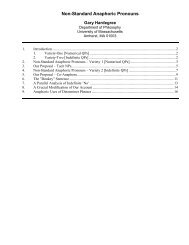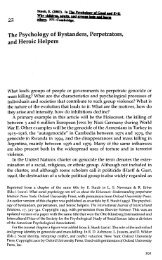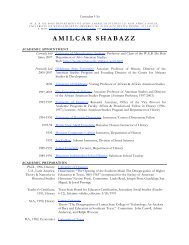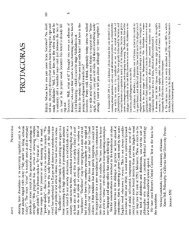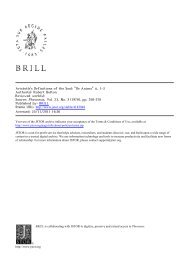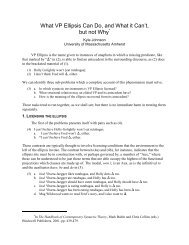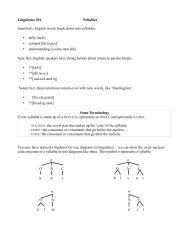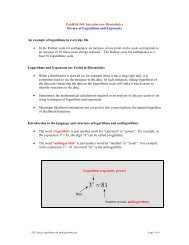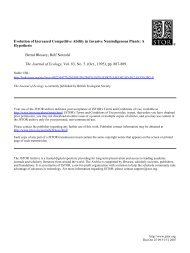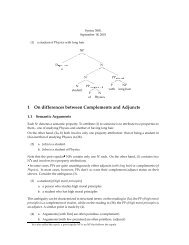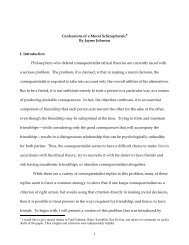Typology and variation in child consonant harmony - University of ...
Typology and variation in child consonant harmony - University of ...
Typology and variation in child consonant harmony - University of ...
You also want an ePaper? Increase the reach of your titles
YUMPU automatically turns print PDFs into web optimized ePapers that Google loves.
TYPOLOGY AND VARIATION IN CHILD CONSONANT HARMONY 5<br />
d. For the period under study, (~2;2), there is a total <strong>of</strong> 9641 transcribed<br />
utterances.<br />
We extracted all <strong>of</strong> the <strong>in</strong>itially stressed adult forms from the glosses <strong>of</strong> the<br />
shape C 1 (C)V 1 (C)C 2 (C)(V)(C), where the follow<strong>in</strong>g applied:<br />
(17) Restrictions on the data<br />
a. C 1 <strong>and</strong> C 2 are both oral stops<br />
b. Either C 1 or C 2 is a velar<br />
c. V 1 is stressed<br />
We elim<strong>in</strong>ated other word types to elim<strong>in</strong>ate factors other than those under<br />
study (e.g. the manner <strong>of</strong> the target or trigger, stress placement).<br />
We divided the words <strong>in</strong>to 8 classes, based on the place <strong>of</strong> C 1 <strong>and</strong> C 2 ,<br />
<strong>and</strong> whether V 1 was front or back (T, K, P = coronal, velar, labial <strong>consonant</strong>,<br />
O = back vowel, I = front vowel):<br />
(18) Word classes<br />
a. KOP c. KOT e. POK g. TOK<br />
b. KIP d. KIT f. PIK h. TIK<br />
To get a first approximation <strong>of</strong> the stages <strong>of</strong> Trevor’s development, for each<br />
<strong>of</strong> the 8 word types we measured the proportion <strong>of</strong> harmonized vs. nonharmonized<br />
forms attested <strong>in</strong> the period up to 1;5, <strong>and</strong> each <strong>in</strong>dividual month<br />
through 2:3<br />
We then def<strong>in</strong>ed more f<strong>in</strong>e-gra<strong>in</strong>ed stages that more closely matched<br />
the changes <strong>in</strong> the application <strong>of</strong> <strong>harmony</strong>, <strong>and</strong> constructed grammars to<br />
model the attested frequency <strong>of</strong> <strong>harmony</strong> <strong>in</strong> these stages<br />
4. The <strong>in</strong>fluence <strong>of</strong> the target<br />
4.1 Typological account<br />
As the constra<strong>in</strong>t motivat<strong>in</strong>g <strong>consonant</strong> <strong>harmony</strong>, we assume an AGREE<br />
constra<strong>in</strong>t (cf. Lombardi 1999, Bakovic 2000) that has a broader doma<strong>in</strong><br />
than the adult version.<br />
(19) Versions <strong>of</strong> AGREE<br />
a. AGREE: <strong>consonant</strong>s <strong>in</strong> doma<strong>in</strong> D must agree <strong>in</strong> place specification.<br />
b. <strong>child</strong> doma<strong>in</strong>: word<br />
c. adult doma<strong>in</strong>: str<strong>in</strong>g-adjacency (i.e. <strong>consonant</strong> clusters)<br />
One could also derive <strong>consonant</strong> <strong>harmony</strong> from constra<strong>in</strong>ts assumed to be<br />
active <strong>in</strong> adult grammars (e.g. Goad 1997), but this leads to prediction <strong>of</strong><br />
unattested patterns for adult languages<br />
Resistance <strong>of</strong> different places <strong>of</strong> articulation to assimilation accounted



